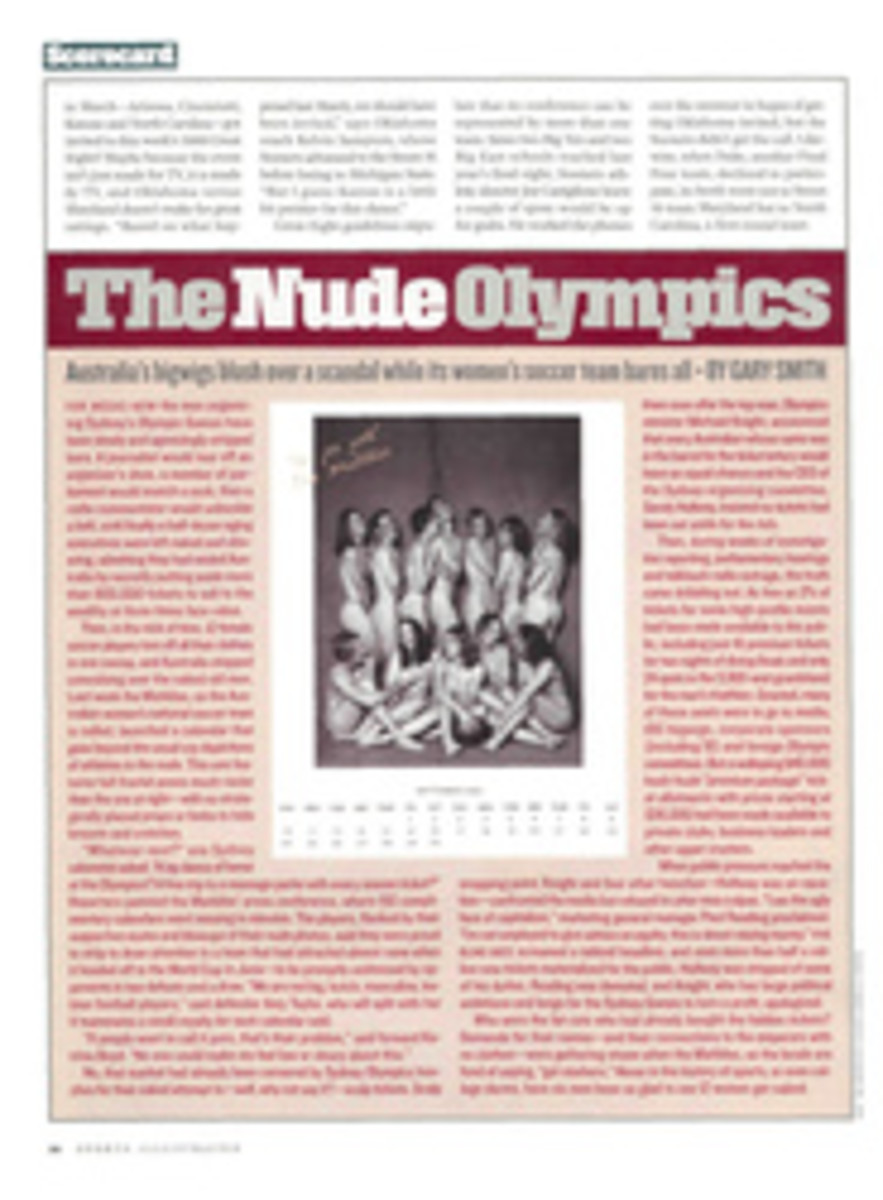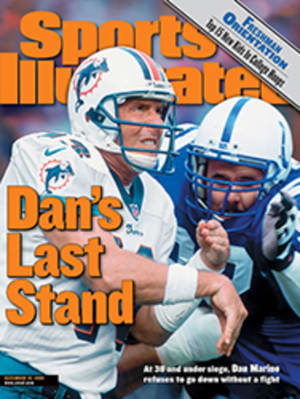
The Quiet American John Mayasich was a wizard on ice but never got a shot to prove it in the NHL
Last Friday, at the annual U.S. Hockey Hall of Fame induction
dinner in Minneapolis, the Wayne Gretzky Award, which honors an
individual for his or her contributions to U.S. hockey, was
introduced. The first recipient, fittingly, was the award's
namesake. Among those who joined in applauding Gretzky was a
broad-shouldered, soft-spoken Minnesotan: 66-year-old John
Mayasich, who in his playing days could have laid claim to being
the Great One of U.S. hockey.
That Mayasich is little known outside his home state is an
accident of time and place rather than the result of any
limitation in his skills. "I don't care who you name, John could
have played with them," says former Harvard coach Billy Cleary,
who starred with Mayasich on the victorious 1960 U.S. Olympic
team in Squaw Valley. "If you were to name an alltime American
team, he'd be on it, either as a forward or a defenseman."
"Like a lot of great American players of his era, John came
along at the wrong time," says Herb Brooks, a former national
teammate of Mayasich, who coached the 1980 U.S. Olympic team to
the gold medal and, later, the NHL's New York Rangers, New
Jersey Devils and Minnesota North Stars. "He had a great shot
and was a tremendous playmaker and skater," Brooks says, "but
what set him apart was that he was the smartest hockey player
I've been around. He was subtle, like a great chess master, and
he made players around him better. It was like he saw the game
in slow motion."
Funny, that's the same thing people said about Number 99.
Mayasich, born in the mining town of Eveleth in 1933, grew up to
be a rangy, rawboned kid (six feet, 180 pounds) who was a
natural at every sport he tried. His parents, Frank and Mary,
had emigrated from what is now Croatia, and his father worked in
the iron mines. John was the 10th of 11 children: six boys, five
girls. He came of age before television, so he spent all his
free time outside playing sports: baseball, football, hockey,
swimming, tennis. In the winter he played hockey on frozen ponds
all day Saturday, even skating home for lunch, then played
street hockey after dark under the streetlights.
"We didn't know it, but we were developing skills," Mayasich
says. "We didn't have hockey nets. We just used a pair of boots
as the goal. If you shot the puck, you'd have to spend the next
10 minutes looking for it in the snowbank. So we always deked
the goalies, and I became a pretty good stickhandler. I learned
to shoot backhand from playing street hockey, where the goals
weren't opposite one another, because we didn't have enough
room. You were always coming at them from an angle."
Mayasich, who played center, never lost a game in his high
school career, leading tiny Eveleth High to 69 straight wins and
four state titles in a row, from 1948 to '51. No other team has
done that. The Minnesota State High School Hockey Tournament is
the most prestigious of its kind in the country, and Mayasich's
name is still all over the record books. He owns 10 tournament
scoring records, including most goals in one game (seven); most
goals, career (36 in 12 games); most hat tricks, (seven in 12
games); and most points, one tournament (18 in three games).
Because hockey scholarships were not given then, Mayasich, who
had been a quarterback and a running back at Eveleth, went to
Minnesota on a football scholarship, although he never played
football. He starred on the ice there, too, leading the Gophers
to the NCAA hockey finals his sophomore and junior years, losing
to Michigan and RPI, respectively. "If there was one, that was
the biggest disappointment in my career," he says of the
overtime RPI loss, in 1954. Mayasich still holds the record for
most points in a Final Four game--seven, against Boston College
in '54.
During college he developed the weapon that was to become his
offensive trademark: the slap shot. He learned about it while
working in, of all places, Eveleth's open-pit mines during the
summer with his friend and teammate Willard Ikola. Ikola had
been the goalie on Eveleth's state championship teams. He went
to college at Michigan, and every year the Wolverines played an
exhibition game against the Detroit Red Wings. Some of the Wings
were experimenting with the slap shot--a little-used novelty
young players like Boom Boom Geoffrion of the Montreal Canadiens
had introduced. Ikola described the shot to Mayasich, who'd
never seen it.
This was before the innovation of the curved stick, and few
players had the strength and coordination to master the slap
shot. "I worked on it quite a bit," Mayasich says. "I had strong
wrists from baseball and tennis, and got to where I could really
let it go. If I was aiming at the right pipe, I'd come within
six inches most of the time. I'd use it when I came down
three-on-two, waiting till the defense backed in enough to let
me get across the blue line. Then I'd slap it, and if the goalie
stopped it there was usually a rebound. If the defense held the
blue line, I'd pass off to a wing."
Mayasich became a scoring machine. His career scoring records at
Minnesota still stand: 144 goals, 298 points in 111 games
between 1951 and '55, a staggering average of 2.68 points per
game. (Gretzky averaged 2.62 points per game in his best
four-season stretch in the NHL, 1982-86.) The Gophers' coach was
John Mariucci, who had played defense for the Chicago
Blackhawks, and he set up an exhibition game between the Hawks
and the Gophers, which Chicago won, 5-3. "John scored two goals,
and I thought he was the best player on the ice," recalls Jack
McCartan, who played goalie for the 1960 U.S. Olympic team and
made it to the NHL for a few games with the Rangers. "There's no
doubt he could have played in the NHL. He was the best American
hockey player I've ever seen."
But Mayasich got no offers to pursue an NHL career after
college. The league was made up of only six teams, all with
Canadian general managers. College players--especially U.S.
college players--were not considered NHL material. Mayasich, who
was in ROTC, also faced a two-year military obligation. "It
wasn't a source of bitterness, since no college players were
being given a chance," Mayasich says now. "But there's still
regret, even to this day, not knowing if I could have done it."
Instead, Mayasich set his sights on the Olympics. The 1956 Games
were held in Cortina d'Ampezzo, Italy, and Mayasich helped lead
the U.S. to the silver medal. The team's biggest win came
against Canada, which the U.S. had never beaten in Olympic
competition. "It was the best I ever played," Mayasich remembers
of the 4-1 victory. He had a hat trick, and in the closing
minutes he had a breakaway attempt for a fourth goal, but his
backhand clanged off both posts before bouncing out. The lone
U.S. loss was to the Soviet Union, 4-0, though it was 1-0 with
just five minutes left. "But I got my revenge," Mayasich says.
That, of course, came in 1960. Mayasich was 26 then, the father
of four (a fifth child would soon follow), working in sales for
a Green Bay television station. He was playing defense for a
topflight amateur team called the Green Bay Bobcats, and he told
Jack Riley, the U.S. Olympic coach, that he would join Riley's
squad in Squaw Valley after the Bobcats' season ended. Mayasich
had only one practice with the U.S. team before the tournament,
but he had a hat trick in the first game, against
Czechoslovakia, on three unassisted slap shots. The team went on
to upset the powerful Soviets, 3-2, in the championship round,
the first time the U.S. had ever beaten the Soviet Union in
international play.
The 1960 Olympic team went 7-0 in Squaw Valley, winning
America's first hockey gold medal. It would be nice to write
that the victory opened doors for U.S. hockey players of
Mayasich's caliber into the closed world of the NHL, but it was
another 20 years and several expansions before that became a
reality. Hours after receiving his gold medal, Mayasich flew
home to Green Bay and the following morning showed up for work
at the television station. He continued to play for love with
the Bobcats until 1970.
The U.S. Olympic win was passed off as a historical oddity: a
blip of achievement brought about by a unique combination of
great goaltending and home-ice advantage. Perhaps some skill,
too. That such blips of achievement followed Mayasich his entire
hockey career was not acknowledged at the highest level of the
game until 1998, when, correcting a long-overdue omission, the
finest American hockey player of his time received the NHL's
Lester Patrick Trophy for outstanding service to hockey in the
U.S.
Not that Mayasich particularly minded the delay. Greatness is its
own reward.
B/W PHOTO: MINNESOTA MEN'S ATHLETICS
"He was subtle, like a chess master. It was like he saw the game
in slow motion."
"I don't care who you name," says Cleary, "John could have played
with them."

